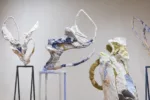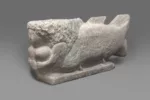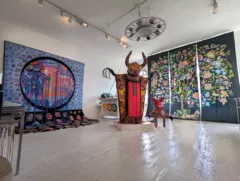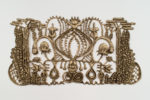[Elizabeth grapples with a comprehensive exhibit of Steve Tobin’s works that collects pieces from several of the artist’s large-scale sculptural series. — the Artblog editors]
In the midst of July’s humidity, thunderstorms, and nerve-shattering fireworks, I visit the James A. Michener Museum in Doylestown, PA for Out of This World: Works by Steve Tobin. This selection of Tobin’s work to date includes samples from his Steelroots, Exploded Clay, Paintings, Sumi Ink Drawing, Doors, Lantern House, Syntax, and Earth Bronzes series.
Large-scale construction; controlled destruction
Tobin is best known for Trinity Root, a memorial to the 9/11 attacks–a bronze cast of the roots of the sturdy tree that partially shielded St. Paul’s Chapel from falling debris as the Trade Center buildings collapsed. Initially, it’s his attraction to danger and dangerous techniques–welding, molten glass, cast metal and a penchant for explosives–that grabs my attention. A video of Tobin detonating tiny Bang Pots with a wry smile reveals the trickster; yet it’s his obvious ease in working on a super-human scale, on equal footing with nature, that powers the work.
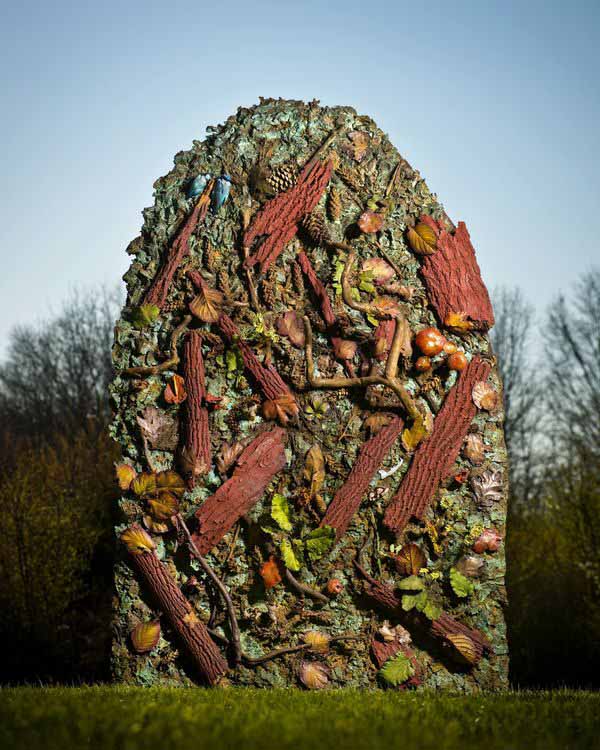
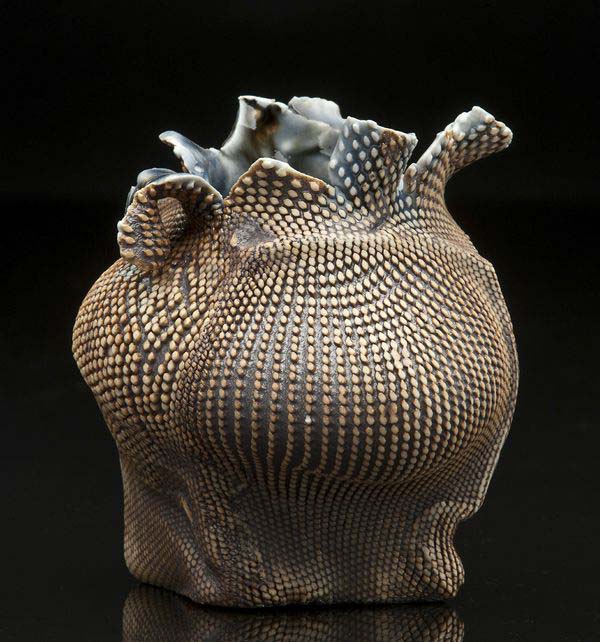
A former student of Peter Voulkos, the titan of large-scale, clay sculptures, who was preternaturally gifted in pushing clay to its limit, Tobin detonates the small Bang Pots and large Exploded Clay pieces in containment, after they’ve been molded and decorated with stamped patterns. It’s the creative equivalent of a controlled burn in forestry, where destruction is the means to an end. Numerous intricate, crusty Bang Pots vary in texture and form like barnacles–and as an interesting side effect, the explosive’s chemical residue randomly alters the glazing process.
Nearly two feet in diameter and filled with colorful molten glass, the Exploded Clay pieces resemble giant lizard eyes or alpine lakes ringed by serrated mountains. Energetically resisting traditional ceramic technique and a clear definition of “vessel” in line with the Voulkos tradition, these two series of work chafe against their own creation. Appearing to be half-created or half-destroyed, they break free from facility and the artist’s hand.
Roots of Tobin’s work
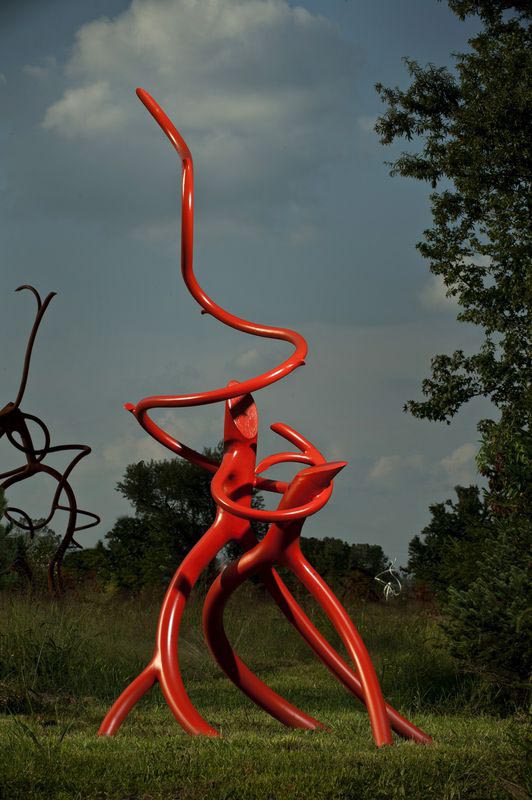
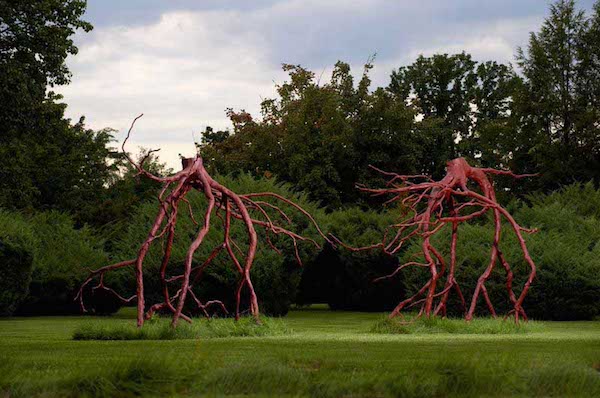
Annie Dillard‘s Pilgrim at Tinker Creek, a landmark ’70s environmental book, mirrors nature’s power through specific observation; like Dillard, Steve Tobin directs our attention to natural phenomenon that we take for granted or ignore altogether. Tobin’s Steelroots, Bronze Roots, and Sumi Ink Drawing series parallel Dillard’s awe of growing trees. Dillard speaks of how “Root tips thrust and squirm between the particles of soil, probing minutely; from their roving, burgeoning tissues spring infinitesimal root hairs, transparent and hollow, which affix themselves to specks of grit and sip.” She relates that a single rye plant sets forth about three miles of root hairs a day, or 6,000 miles of root hairs in a cubic inch of soil.
For Dillard, the heroic arises from the microscopic, as incalculable single-celled root hairs grow relentlessly. Tobin follows nature’s lead, intrepidly mastering multi-step processes for working in metal, glass, and clay on a monumental scale. Tobin’s relationship to trees evolves in two directions: his Bronze Roots series directly casts root forms from actual trees, while the Steelroots series abstracts root and human gestures, severing the direct link to nature; the latter’s strength lies in dividing and framing the surrounding environment.
Tree-inspired work by Roxy Paine
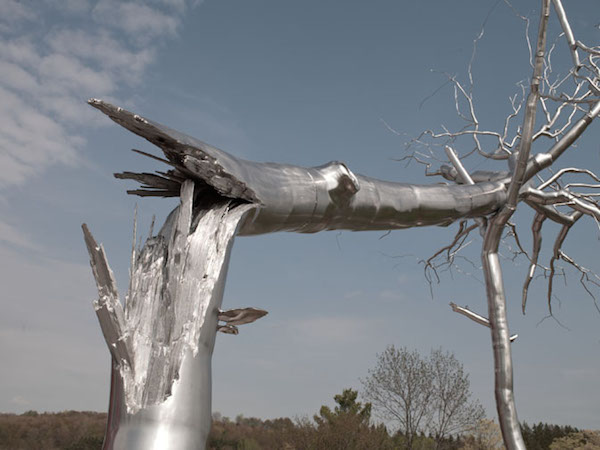
Philadelphians can view other tree-inspired work this summer, as Roxy Paine’s Symbiosis is on view at Iroquois Park at the northern end of the Benjamin Franklin Parkway. In contrast to Tobin, who focuses on roots and hidden structure, Paine fashions Dendroid sculptures (from the word “dendrite,” which means “branching”) based on the visible part of the tree in chilly, antiseptic, industrial, stainless steel. “Symbiosis” presents a random tree that miraculously fell into the notch of another.
Like Tobin, Paine looks for natural occurrences, and “Symbiosis” faithfully reproduces the form of a specific, fallen tree; yet here, Paine’s choice of chilly, medical or surgical stainless steel conjures up broken connections in the human brain and nervous system. I shiver, thinking of the actual, physical manifestation of Alzheimer’s disease or dementia. Living trees or dendrites might be damaged–yet in a healthy individual, the overall system still functions through the growth of alternative pathways.
Given the fact that many, many trees fall in nature, such a chance composition is actually not so rare; realized in frigid metal instead of wood and leaves, which would decay, “Symbiosis” persists artificially, separate and lifted from nature: a signpost along the highway pointing out that damage and coping spur evolution.
Sculpture inspired by natural processes
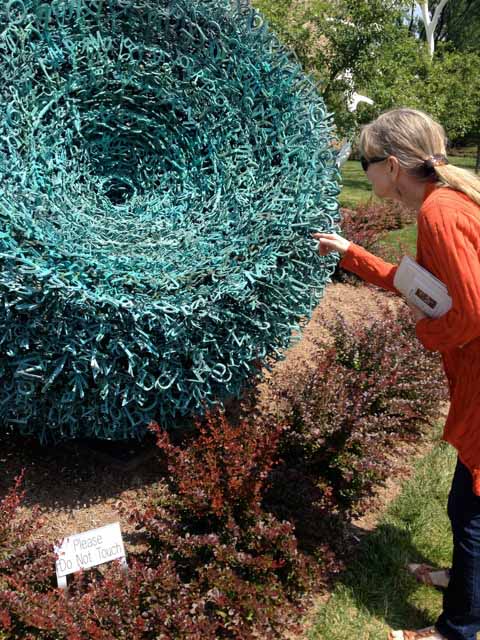
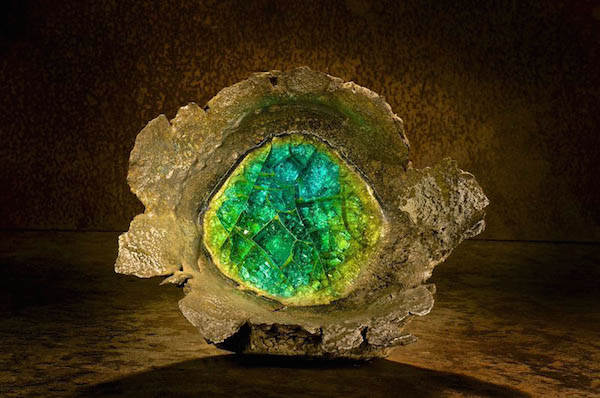
Referencing another positive that comes after decay, loss, or death, Tobin’s Earth Bronzes are monuments to compost and what environmentalists call “duff”–the rich, partially decayed organic matter that carpets the forest floor. Dillard laughs and calls nature “profligate…and though nothing is lost, all is spent.” Expertly cast in bronze from carefully excavated sections of the forest, Tobin’s pieces recreate each delicate leaf, branch, and pine needle in exquisite, sturdy, and deep relief. Corn cobs, flowers, gourds, fish, vegetables, bread, and chunks of bark are added artfully, indicating a human presence enjoying being overwhelmed by nature’s extravagance.
The works resemble giant heel prints or flat cornucopia, burgeoning voids, textured tombstones or doors, and they tie in nicely to Tobin’s earlier, more cheerful, colorful cast-glass Doors, found nearby, but not near enough, in another gallery.

Out of this World: Works by Steve Tobin is a feast for the senses, though I have reservations about the show as a whole. For me, there are too many different bodies of work presented at once, making it hard to concentrate on the dense information and diverse skills presented in each series.
Also, the Michener has acquired a varied array of permanent works that make holding a cohesive exhibition of large sculptures problematic, and ironically, these are evolutionary issues. What is kept? What dies? Which is sold, suppressed, stored or lost? Steve Tobin broadcasts nature’s power loud and clear: I’m in the struggle of death and fecundity, not safe at the perimeter, yet nature still comes across as the most efficient but broad-minded curator around.
Out of This World: Works by Steve Tobin is up at the James A. Michener Art Museum through October 26th, 2014. Check the museum’s calendar for special upcoming events, including Steve Tobin studio tours on August 21 and September 5, and a Nai-Ni Chen Dance Performance and Meet-the-Artist on August 27.


